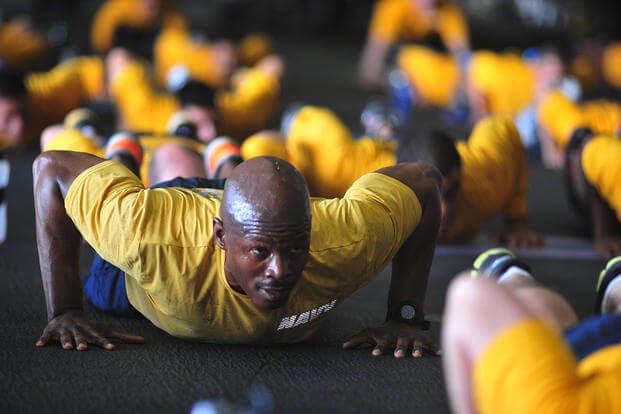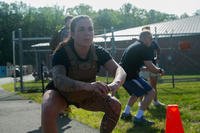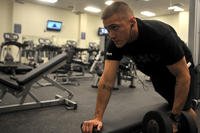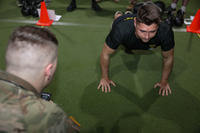Many endurance athletes find the run and swim the easy part of taking the Navy physical screening test (PST) when they're applying to become a Navy SEAL, SWCC, EOD/diver or rescue Diver or Rescue Swimmer.
However, many of those same athletes struggle for a short time with the upper body strength portions of the test.
Here is an email from a young man who competes in cycling races as he preps for the PST:
Stew, thanks for all the great content. I am a competitive cyclist and need help with push/pull strength and muscle stamina for PST in my future. Question: I am working to improve my pull-up and push-up numbers. I am now at the point where I can do about five to six. I am following the workouts in the 12 weeks to BUD/S program. What can I add to develop the muscle group involved with this specific motion?
Many endurance athletes who train with us typically find that they show weakness in high repetitions of push-ups, pull-ups and sometimes even sit-ups. These three exercises start off as strength exercises, but you have to build up your muscle stamina and turn them into an endurance exercise if you want to max out the scores during the two-minute test. Your first few reps of pull-ups are strength, and the 20th repetition becomes a product of muscle stamina.
The good news is that most endurance athletes improve very quickly with both strength and muscle stamina. In fact, my first recommendation is to complete the program you're currently doing to see how you improve.
Many endurance athletes who start with us crush our group in the runs and swims, but initially get crushed under the pull-up bar. However, in a four- to six-week period, after adding these upper-body exercises to your week (every other day), you will find that your growth curve on calisthenics skyrockets, doubling and even tripling in your PT numbers.
Typically, before two months, all the endurance athletes have caught up to the other athletes in the PST events that you struggle with today. Just keep doing your program.
However, if you do not see improvement in a month of doing calisthenics only, I would consider adding a supplemental lift during a second workout on that day. It only will take 20-30 minutes, but it will help you with some of the underlying strength issues you are having.
Make sure you do the supplemental lift on the same day you do all the other upper-body events. Avoid back-to-back days with the same muscle groups getting worked with this type of volume. You will need a day in between to recover your upper-body muscles.
Supplemental Lift to Help with PST Events
Warm up with short pull-up and push-up pyramid from 1-5: 1 push-up, 1 pull-up, 2 push-ups, 2 pull-ups … keep going up to 5/5.
Repeat 3-4 times
- Bench press 5-10 (moderately heavy where you might have one more rep in you when you hit five or 10 reps). If you go heavier, do five reps. If you go a little lighter, do 10 reps.
- Pulldowns 10 -- go heavy
- Hanging knee-ups -- 10-20 -- keep arms/shoulders slightly flexed
- Rows -- 5-10. Go heavy (use weight machine or dumbbells)
- Biceps/military press 10 -- make a single movement out of the two isolation exercises. The dumbbell biceps curls roll right into a military press and repeat for 10 reps.
Only Do This Once -- Max Rep Test Session to See What You Have Left
- Max pull-ups
- Max push-ups 1-2 minutes
- Max sit-ups 1-2 minutes.
Work on your goal pace (20-25 reps in 30 seconds), then PT reset
Another method is to finish the 12-week program you are on now, then move into a strength/hypertrophy cycle that focuses on more lifting (warming up with calisthenics), while you maintain your cardio speed and endurance.
Programs like tactical strength or the fall/winter lift cycle are not bad ideas, especially if you need to gain 10-15 pounds of muscle to assist with overall durability to get through selection challenges (logs, boats, rucking or equipment/man carry).
Increasing your strength is the key to many of your issues. You can increase your strength through calisthenics if you prefer, but you may find even greater results with weights after that initial calisthenics strength growth curve flattens out.
Stew Smith is a former Navy SEAL and fitness author certified as a Strength and Conditioning Specialist (CSCS) with the National Strength and Conditioning Association. Visit his Fitness eBook store if you’re looking to start a workout program to create a healthy lifestyle. Send your fitness questions to stew@stewsmith.com.
Want to Learn More About Military Life?
Whether you're thinking of joining the military, looking for fitness and basic training tips, or keeping up with military life and benefits, Military.com has you covered. Subscribe to Military.com to have military news, updates and resources delivered directly to your inbox.
















